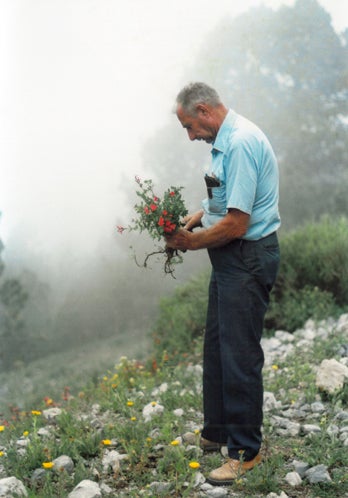
By Dr. David Creech (from SIDA 17(4): 847. 1997., and Native Plant Society of Texas. Native Pl. Soc. Texas News 15(5), September/October 1997.)
Lynn’s passing June 28, 1997, was a hard blow to the gardening world. Another mighty oak has fallen. A living legend is gone. For many of us Lynn was one of those folks you run across in life you want to end up like. I knew Lynn from the late 60s as a TAMU Horticulture major working in the fruit science end of the program and, as a graduate student at TAMU, I crossed trails with him many times in the 70s. I was then looking for various native and exotic fruits adapted to East Texas conditions (pawpaws, blueberries, hawthornes, jujubes, etc.) and Lynn was the man to see. From TAMU to SFA and then the Arboretum and suddenly Lynn’s footprints and mine crossed much more often. Trips to Mexico, to the backwoods, to nurseries, to gardens or just out and about with other plant friends was part of the plan. Simply put, from the beginning, Lynn struck me as a genius with character.
For many of us, Lynn really was a legend in his own time. His impact on southern landscapes reaches almost as far as his effect on people. I could never decide if Lynn was born 100 years too late or too early. Both fit. Always a quiet reservoir of plant knowledge, always eager to learn and share, Lynn was blessed with humility and great humanity. His expertise was unquestioned; whether it was a botanist, horticulturist or adventurous landscape designer visiting the state, Lynn was always high on a list of people to see. Lynn was more a true plantsman than a true nurseryman. Hard for him to stay in one spot, hard for one to make a firm appointment with, Lynn liked to wander here and there collecting seed or plants. He enjoyed connecting with someone who knew about this or that plant or that person who was working with.
Throughout his career–and there’s no point in recounting all the names and locations of Lynn’s nursery haunts–Lynn brought adventure and excitement to the nursery and landscape industry in the south. The Mexico oaks are only the tip of the iceberg. Many gardens across the south are blessed with living memorials to the oh-so-many plants that Lynn showered on the world. Who can’t appreciate Lynn’s big leaf yaupon? The Arboretum’s Lynn Lowery American Holly selections–cuttings grown from superior East Texas trees–are now robust 10′ females with large berries and clean foliage.
There’s that special Oakleaf hydrangea sporting large tresses and good fall color over by the perennial border; it deserves a name–collected by Lynn near Angola Prison in Louisiana. Lynn felt that the Wisteria frutescens, our native Westeria–white and blue forms–were worthy of greater use and certainly easier to manage than those rude Japanese and Chinese cousins. Hmmm…what about the soapberry with exceptionally narrow leaves? What about the Hersperaloe from Mamuluke pass? The Mahonias? For those of us who knew him, the list never ends. And that is what Lynn would want us to think about him when we thought about him–the plants.
Lynn’s impact amazes many of us academic and non-academic types who write and speak for a living in the amazing gardening world of Texas. Lynn wrote little and spoke less. Yet, his followers are legion. The power of his message was more than just the plants. It was an attitude to live by. Before it was politically correct, Lynn spoke and wrote quietly on biodiversity, taking advantage of microhabitats, and understanding the importance of site preparation, plant community development, natural form in design, using superior and adapted natives and exotics. One day Lynn and I were working along a fence row south of Navasota off a red clay road, collecting seed and cutting from a bright orange-berried, deciduous holly that mixed into a swarm of native trees and shrubs and herbaceous and God knows what. Lynn said that he didn’t see how you could much improve on where we were at–kind of God’s design.
While Lynn was no doubt an adventurous gardener, he didn’t stop there. He also became a role model to live by. I always felt that business to Lynn–even money–was just a distraction, something that had to be dealt with as little as possible. Down deep, he’d rather give away plants than sell them. Lynn’s goal in life was to work at what he loved to do and share it with the world. Lynn did that better than anyone. Perhaps more important than the plants or the gardens, maybe Lynn’s greatest talent was in putting people together. Whether connecting medical researchers and cancer foundations with rare cancer-fighting plants like the Happy tree of China, or locating Taxus globosa in the mountains of Mexico for the Arnold Arboretum, or hunting down a particular genotype for a botanist, or chasing down a natural hybrid between two related genera–Lynn was always there to help out–to make something happen. Amazing to me, he never thought much about all this. He seemed to think he wasn’t really doing all that much, that everyone else was doing a lot of good or that others work was “really important.” That’s what Lynn saw in people–the good. I think all the people, the plants and gardening did that to him. Matt Welch, one of my students, gave me this quote the day after the Lowrey memorial and the message kind of stuck. “Maybe a garden is not like an artistic creation, but more like a relationship. It is not so much designed as it is nurtured and managed. Imperfections, inconsistencies, and incongruities say that the relationship has some vitality to it, and that the gardener is engaged in a dialog and doesn’t need to have the last word.”–Tom Little, 1996. Lynn Lowrey never even intended to have the last word; his gardens, his plants and his people will do it for him.
